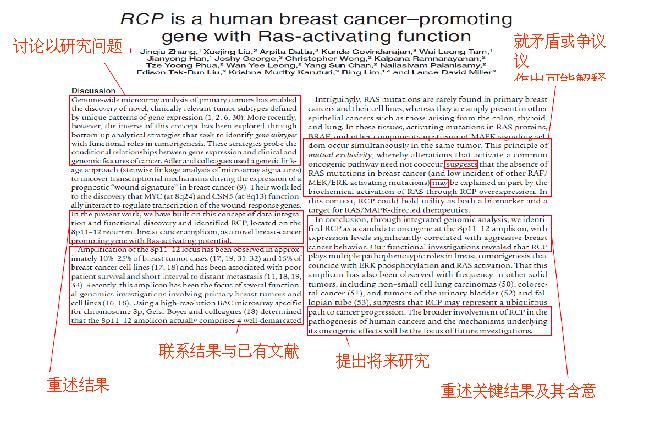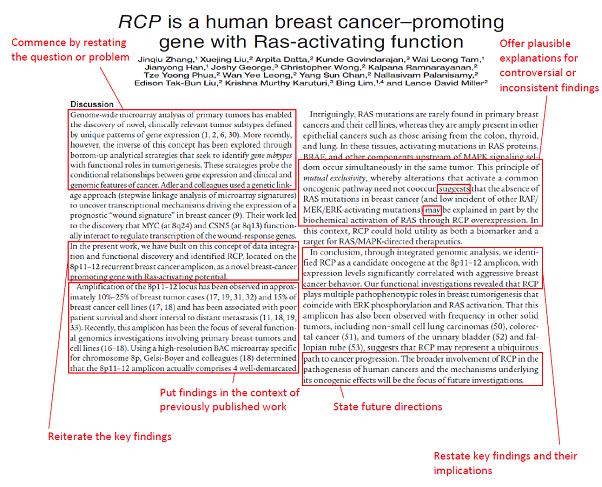博文
讨论:你的研究有何意义?
|

“讨论”部分非常重要。在这部分,你要把“结果”中展示的证据线索和“引言”中的背景资料关联起来。遗憾的是,许多作者(特别是来自非英语国家的作者)常常不够重视“讨论”部分,认为只需把结果罗列出来,然后让读者自行去得出结论即可。但是,给出结果而不说明其意义只会造成随意解读,从而影响研究获得应有的影响力。而期刊编辑往往希望论文能推进该研究领域,并形成影响;所以有必要善用“讨论”部分来尽可能增强论文的影响力。
好的“讨论”可以在开头先重申一下“引言”中提出的研究问题和假设,接着总结一下你的主要研究结果。这样一来,读者对于你是否推进了该领域的研究就一目了然了。从最重要或最相关的结果写起,然后再转向相对次要的内容。此刻暂不要讨论有争议或者难以解释的结果。这个阶段,你只须描述那些能直接回答“引言”中提出的问题或与假设直接相关的主要结果。不要用那些数据不支持的“大而空”的语言,也不要夸大结果的重要性。用“suggests” 比用“shows”更好,切忌使用 “proves”。此外,要尽量不要重复结果”部分的内容,而只需简要说明主要结果然后再谈其含意。这部分需要变换时态,叙述你的结果以及文献结果时用过去时,论述其意义时用现在时。
“讨论”的第二部分常被忽视,并往往造成拒稿。重申问题和结果之后,还需要陈述其相关性和重要性。你需要把你的结果放在文献研究背景中加以比较,并讨论其意义。这部分构成了“讨论”主体;他告诉读者(当然还有编辑):从已有文献的基础上来评价,你的结果到底有什么意义?它们与其他研究者的工作之间存在什么关联。你的研究可能存在备择解释,对此应予提及并尽可能排除(或者至少论证它们的可能性很低)。如果仍有备择解释无法排除,你的研究就属于“尚未完成”,或者至少是“尚在进行中”;在这种情况下,你需要在“讨论”的结尾部分,提出将开展哪些实验来进一步排除备择解释或确认哪种解释才是正确的。
主要结果和背景的关系理清之后,就可以提及有争议或难以解释的发现,并提出可能的解释。没问题,这里你可以猜测,只要不要太过分。关键的问题是,你讨论和阐述了这些问题,而不是置之不理。“讨论”部分不能出现新术语或新结果;所有结果都该在“结果”部分叙述完整;所有术语也应在“引言”中就提出。最后,“讨论”部分要解释一下此研究的局限性。与其等审稿人指出,不如自己提出;这样也许反而会增加正面审稿意见从而缩短发表周期。一个研究存在局限性本身并不是问题,大多数研究都有这样那样的局限性。所以重要的是要承认它并提出在进一步研究中如何克服。在阐述完局限性之后往往紧接着就是描述未来的研究。
有些期刊有单独的“结论”部分;就算没有,也要在“讨论”的最后一段点明研究的结论。最后一段(或最后一部分)应简要复述一下主要研究结果及其重要性,陈述该研究如何推进了本领域的研究,但不要用完全相同的语言。要提及结果的新颖性和重要性,但再说一次,不要夸大其词。如有必要可以提出进一步研究,如果本工作是初步研究则进一步研究可放在最后一句。若不是初步研究,就可以用明确的措施来总结本研究的影响,但仍要注意不要夸大其词。。
示例
下图节选自《The Journal of Clinical Investigation》上一论文的讨论部分(doi:10.1172/JCI37622; 经同意转载)。其中显示了讨论部分的一些要素,其末尾是一个结论段落。

核对清单
1. 开始先复述研究问题,然后陈述主要结果。
2. 过去时叙述结果,现在时谈意义。
3. 将研究结果同现有文献作比较,陈述其意义。
4. 陈述所有结果的意义,不要忽略那些“不便提及”的内容。
5. 不要在“结果”部分简单重复其他部分已有的内容,不得引入新术语/报告新结果,或夸大其词。
6. 给出本研究的局限性和将来研究方向。
7. 结尾用明确的措辞陈述本研究的相关性和重要性。
英文原文
Discussion: what does it all mean?
The discussion section of your manuscript is critically important. It is where you pull together all the ‘threads’ of evidence you have presented in the results in the context of the background you presented in the introduction. Unfortunately, many authors, particularly those from non-English-speaking countries, overlook the importance of this section considering it sufficient to merely present their results and allow the reader to draw their own conclusions. However, presenting your results without describing their implications leaves them open to interpretation and reduces the impact they could have. Journal editors want papers that will advance the field and generate an impact; therefore, use the discussion wisely to maximize the impact of your findings.
A good discussion will begin by restating the study question and any hypotheses presented in the introduction. This should be followed by a summary of the major findings of your study so that it is immediately clear how you have advanced the field. Start with the most important or relevant finding and then move to progressively less important ones. However, do not yet discuss results that are perhaps controversial or difficult to explain. At this stage you only want to describe the major findings that directly answer the research question you set out in the introduction and/or those that directly relate to your hypotheses. Avoid making grand statements that are not supported by your data and/or overstating the importance of your findings. The word “suggests” is preferable to “shows”, and the word “proves” should never be used. Also, there should be minimal repetition with the results section, with only brief descriptions of the main findings required before launching into their implications. A mixture of tenses is required, with the past tense used to describe individual results and the results of previous studies, and the present tense used to describe their implications.
The next part is the component of a discussion that is often overlooked and a frequent cause of rejection from journals. Having reiterated your initial question and major findings, you need to describe their relevance and significance. This is where you put your findings into the context of previously published literature and discuss their implications. This part forms the bulk of the discussion section, showing the reader (and importantly, the journal editor) what your findings actually mean in the light of the existing literature and how they relate to the efforts of others. All possible alternative interpretations of your study should be described and excluded (or at least shown to be unlikely) wherever possible. If alternative interpretations remain viable, the study is considered ‘incomplete’, or at least ongoing, and experiments to rule out the alternatives or determine which of the alternatives is correct should be described at the end of the discussion section as future research.
Once the major findings have been put into context, any controversial or difficult to explain findings should be mentioned along with plausible explanations for them. It is perfectly OK to speculate here (but not too wildly), but it is absolutely essential that these findings, and any inconsistencies, are discussed and addressed rather than ignored. No new results or terms should be introduced in the discussion section; all findings should be described in the results section and relevant terms will all have been introduced in the introduction section. Finally, any limitations of the current study should be explained. Peer reviewers are likely to comment on such limitations anyway, so it is best to be ‘up front’ about them and state what they were; doing so might even improve your chances of a positive peer review and thereby shorten the time to publication. The fact that your study has certain limitations is not a problem in itself, and most studies have limitations of some sort. It is therefore important to acknowledge these and describe how they can be addressed in future research. For this reason, the description of limitations is usually followed by a description of future research.
Some journals have a separate conclusions section, but even in those that don’t, the same content should be merged with the discussion and contained in the last paragraph. This final section/paragraph should briefly restate the key findings and their significance, describing how your study represents an advance in the field, but avoiding direct repetition. The novelty and significance of these findings should be mentioned, but again, it is important not to over-emphasize either of these. Future studies should be mentioned where relevant, and can be the subject of the final sentence if the current study is preliminary. If your study is not preliminary, end with a strong statement that summarizes the impact of the study without over-stating its importance.
Example
The figure below, showing excerpts from the discussion section of paper published in The Journal of Clinical Investigation (doi:10.1172/JCI37622; reproduced with permission), shows some of the important components of a discussion section and the concluding paragraph at the end.

Checklist
1. Start by restating the problem/research question and then state the main findings of your study
2. Describe results in the past tense, but implications in the present tense
3. Put findings in the context of the existing literature to describe their implications
4. Describe the implications of all results obtained; do not ignore ‘inconvenient’ ones
5. Avoid repetition, introducing new terms or results, and making grand statements about the importance of your findings
6. Describe the limitations of your study and future directions for research in the field
7. End with a strong statement describing the relevance and significance of your study
Dr Daniel McGowan
分子神经学博士
理文编辑学术总监
https://blog.sciencenet.cn/blog-288924-478622.html
上一篇:Respectively
下一篇:比较